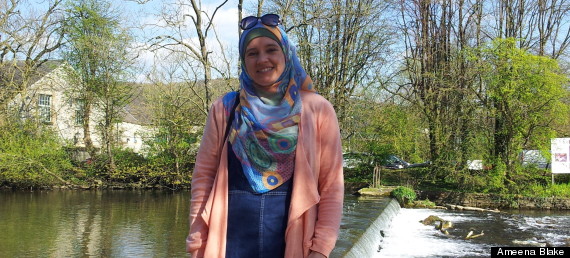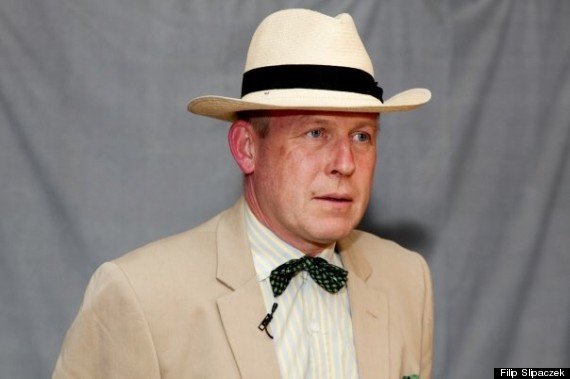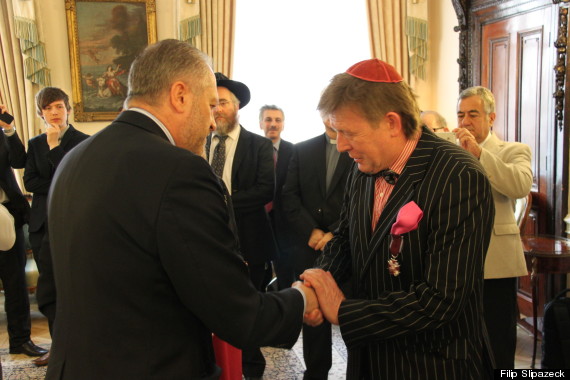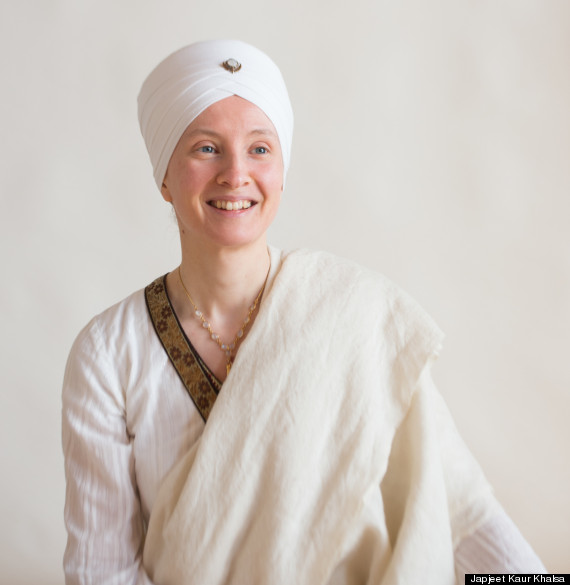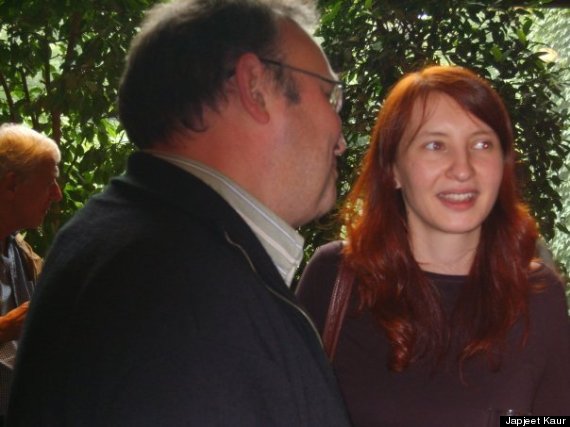Throughout November, The Huffington Post UK is featuring its Beyond Belief series, chronicling the remarkable lives of Britons who've taken on their faith to create a force for change.

Picture a typical religious convert and you are likely to conjure up a zealous American-style preacher, or the ginger-bearded jihadi fronting recruitment videos for Islamic State in Syria. The phrase "the fervour of the converted" is common parlance, giving the impression that converts are attracted to extreme aspects of faith.
But detailed research has shown that the most common religious converts are actually young, educated women. According to experts, religions have different "selling points", characteristics that a person might seek out: new Christians tend to be seeking salvation, Muslim converts look for discipline, Buddhist adoptees are drawn to the spirituality of the faith, and Jewish converts are attracted to the strength of community.
Rabbi Jonathan Romain, who himself teaches a conversion class for would-be Jews at Maidenhead synagogue, estimates 1,000 people each week either convert or begin to practice a new faith.
"Evangelical churches and African churches are doing best within Christianity, with Baptists and Methodists losing out, almost to the point of getting close to lack of sustainability - but the biggest gains in the UK are being made by Islam," Romain says, though he cautioned there were no exact figures.
"The existence of this missionary zeal casts a new light on the state of religion in this country," he says. "It is not true that we are an increasingly godless society that has turned its back on religion. There may be a dissatisfaction with some forms of worship, but people still have the big questions — Who am I? What is life for? Where am I heading? — and are seeking answers wherever they can find them."
Research by Rabbi Romain has shown some "distinct patterns are emerging". Each religion has a "selling point", he said.
"Islam is seen as providing a sense of purpose and direction; Buddhism as a path to self-knowledge and inner calm; Christianity as offering personal salvation and eternal life; while Judaism is good at community and camaraderie. Of course, each aspect can be found in all the faiths, but these are perceived as their distinctive characteristics."
And the ages of those converting to different religions seems to bear this out. The greatest number converting to Christianity are between 15-20 years, coinciding with the age many teenagers confront the challenges of adult life. Those becoming Muslim are very often 19-26, a time when one might seem to cast off youthful mistakes and seek new direction. Adopting Judaism is most common for those in the 25-35 range, when people perhaps are planning marriage and a family with a Jewish partner, like Charlotte York, the Episcopalian Sex and the City character who converts to marry her Jewish lawyer Harry Goldenblatt.
Because Judaism is inherited by children through the mother, there are five times as many female as male converts. Male converts also face the rather daunting prospect of needing to be circumcised, and many mixed-faith partnerships will continue with a non-Jewish husband, even if the children are raised Jewish.
Islam, conversely, has an equal ratio of male/female converts, Rabbi Romain says, because it "manages to give out an image that is both macho for men and protective for women." Additionally, separate 2011 research on Muslim conversion by Faith Matters found that there is "no link to support the claim that most conversion is driven by the desire to marry a Muslim."
Clear trends have also emerged of what faiths are more likely to convert to another - and it is usually because there is something perceived to be lacking in their own culture.
Jews are more likely to become Buddhists than any other faith. "Its concentration on the inner soul appeals to those turned off by an emphasis on rituals, while it lacks the historical baggage of Christianity and Islam," Rabbi Romain says.
The number of Jews attracted to Buddhism has even coined the phrase 'Jewbu' in America, Leonard Cohen is an ordained Rinzai Buddhist monk, and others include Jewish-born actress Kate Hudson and Beat poet Allen Ginsberg.
Church of England members often become Muslim, Romain said, preferring its "definite stance on issues compared to 'CofE wooliness'".
Catholics are the most likely to seek to convert to Judaism, drawn to it being the "roots" of their own faith, and a solution to wrestling with theological questions over "virgin birth and resurrection".
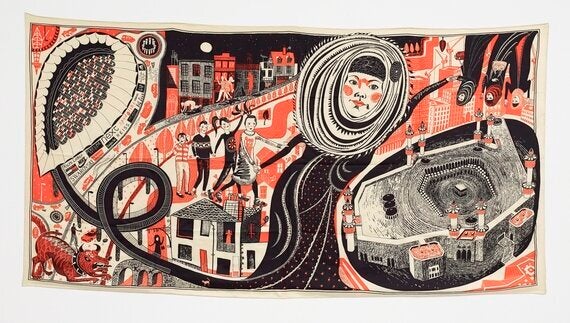
The calling to take on a new faith is the subject of one of the centrepieces of Grayson Perry's 'Who Am I?' exhibition at the National Portrait gallery on British identity.
The framed silk 'Ashford Hijab' depicts Kayleigh Khosravi and her four children, who live in Kent. "Perhaps surprisingly to some, Kayleigh represents the most likely group to convert to Islam in the UK," Perry's caption reads below the framed scarf.
"What does Islam offer to a young white woman in her twenties? The answer, I found, appears to be a refuge from the nagging consumer pressures and constant, often sexual, scrutiny of women all pervasive in western society.
"Conversion also offers a strong and supportive sisterhood within the congregation of the mosque. I have portrayed Kayleigh and her children on the symbolic path from the temple of consumerism that is the Ashford Designer Outlet Centre to the focal point of the Muslim faith at the Grand Mosque in Mecca," the caption says.
Conversion to Islam has often been a focal point for the conversation around changing faith in Britain, particularly as several high profile terror cases have involved converts. The murderers of Drummer Lee Rigby, who was stabbed to death in Woolwich in 2013, were both converts, as was the former cage-fighter who beheaded a grandmother in Edmonton in north Londn earlier this summer. One of the handful of youths arrested in connection with the high-profile "Sharia" patrol in east London was 19-year-old convert Jordan Horner, who is close to radical preacher Anjem Choudary.
But as Perry's piece illustrates, they are not the archetypal convert. Young woman are just as likely to convert to the religion, according to both the Muslim Council of Britain and research undertaken by think-tank Faith Matters with Swansea University in 2011, which estimated there were 100,000 converts to Islam in Britain.
"It is not reflective of the Muslim convert community, who can act as a bridge within local areas between Muslims and non-Muslims. Muslim converts are not a security threat, nor are they a population that should be at the mercy of those within Muslim communities who want to push obsolete and unethical cultural practices,'" says Fiyaz Mughal, director of the think tank that published the research.
'IF I AM GOING TO FOLLOW A FAITH, I WANT IT TO BE BLACK-AND-WHITE'
Lecturer and author Ameena Blake, 41, a mother-of-four from Sheffield, converted to Islam at the age of 18, and is now one of the assistant secretary generals of the Muslim Council of Britain
Ameena Blake, a Muslim convert who became a top official in the MCB
"I came from a very academic family. My father was a professor of linguistics at Sheffield University, we always mixed with different faiths and cultures. We were brought up Church of England, believing in God and attending Sunday school.
"I did feel there was something missing, I always believed in God, but I was questioning the Bible. I found it so contradictory and the vicar would say 'well, you just have to accept it with your heart, that's faith'. I am a very black-and-white kind of person and I thought, if I am going to follow a faith, I want it to be something straight from the horse's mouth.
"I had a Pakistani friend I went clubbing with at 17, and she had a next-door neighbour who was a white Muslim convert. I had begun to ask my friend about Islam, all the questions I'd asked the vicar, and she she said we should ask her neighbour. I asked him the questions I had and he had found all the verses in the Quran that explained everything I wanted to know, in a book written centuries ago by an illiterate man in the deserts, with scientific facts in it that we know now to be true. I accepted Islam straight away because it had been proven to me. “That was it for me, it was clear that I could question and get answers, I could never get that from Christianity. I had loved the stories of the prophets in the Bible, of Jesus, and loved God, and the Quran allows me to retain that. It is the next edition, it is perfected and preserved, the direct line.
"At the time it was very unusual, now we have people who come to Islam every day, we have people flooding to us, full families embracing Islam every single week. Pretty much all my friends are convert Muslims.
Embracing the hijab came a year after converting
"My mum was concerned I was going to be oppressed. She saw Muslim women walking five paces behind husbands and was worried because she knows what a strong character I am. But that is the South Asian culture predominant in the UK, not Islam. I decided to wear the hijab around a year-and-a-half after becoming a Muslim. I have seen a huge difference in people's reactions. It is a very personal journey and sometimes new Muslims feel under pressure to do things quickly, but they shouldn't rush, it has to be your own choice.
“A lot of converts' families nowadays are worried that they will be drawn into terrorism, but I think some people are inherently angry, they are always going to be attracted to this negative and violent aspect. It could be Britain First, it's the same, it's all negativity. I think most people convert very innocently, you're like a newborn child, a blank slate waiting to be written on. Obviously that makes people quite vulnerable and targeted by the jihadi groups, using just a few verses from the Koran out of context. You could do the same with the Bible and make it into an extreme, warmongering text. It's like a cult, it's not Islam."
'IT IS LIKE THE BIGGEST AND BEST CLUB IN THE WORLD'
Financial advisor, Filip Slipazeck, 56, a divorced father-of-two from New Barnet, London, is in the process of converting from Catholicism to Judaism
Filip Slipaczek is converting to Judaism
"I was born on a council estate in Winchester, with an Irish mother and a Polish father, who did have Jewish blood. He told me that he had some Jewish heritage when I was 17, and I said, "oh no, how many more crosses do I have to bear?"
"It was pretty rough growing up, we had air rifles shot at us. I was told aged four 'you don't belong here'. It was not a nice environment. I went to Catholic primary school, got to university and studied politics, and have worked in financial services for many years [and] now running my own business. My boys went to Catholic school, and I returned to the religion, but when Pope John Paul died I felt a real void.
"For the last decade, I started to closely explore my Polish roots, becoming more involved in community relations. It drew me into the Jewish community and into Polish-Jewish dialogue. I love the Jewish community, I go to an Orthodox synagogue every week now. It's a different mindset, completely.
Filip Slipazeck feels at home with Orthodox Judaism
"Now I feel like I am completely integrated, though I have not yet officially converted, because it can take up to five years. I have sat next to the former Chief Rabbi Lord Sacks at the Western Marble Arch synagogue, I pray with the head of the United Synagogue Stephen Pack at Hadley Wood synagogue. Chabad, a Hasidic Jewish outreach movement, have been very welcoming. I learn Torah, I can argue with any rabbi on the Parshah. I would have converted earlier, but a relationship broke down that really put things on the backburner.
"It is easier to convert through the Jewish progressive movement, but having been brought up a Catholic, I am drawn to the traditional model of Orthodox Judaism. I have never encountered intolerance. I have found them extremely welcoming. I can't take part in the minyan [10 adult Orthodox Jewish males which are needed for prayers to take place], and that is sometimes a bit awkward [but] I am often counted in by mistake. One rabbi, who accidentally counted me in, said "Filip, I'm going to strap you to the floor, and apply the knife", joking about circumcision.
"I really found that to be the best compliment. It is like being in the best and biggest club in the world. The biggest family in the world. I could make an advert for Judaism. Converting is hard, but at least you can still have a drink and you don't have to be celibate."
'I FELT I HAD COME HOME TO SOMETHING'
Yoga teacher Japjeet Kaur Khalsa, 35, was born in Belgium but moved to Leicester after becoming a Sikh
Japjeet Kaur Khalsa began wearing a turban shortly after she converted
"I was brought up in Weelde, near Antwerp in Belgium, my Western name is Nele Bemong. I was quite religious as a child, with quite religious Catholic grandparents, my parents much less so. I was baptised, and went to Catholic school and university. I was always a spiritual child, I prayed a lot and talked to God before I went to bed. After the age of eight or nine I began questioning God when some people very close to me died and I couldn’t understand why God would allow that. Other Catholic concepts, like for example, original sin, also did not make sense to me and it was hard for me to agree with what institutionalised religion had turned the intrinsically very beautiful teachings of the Bible into. By the time I went through high school, I had really stopped practicing anything.
"I started practising Kundalini yoga in 2008 for back problems I was experiencing. It is the most original form of yoga out there, a very spiritual form of yoga. It is historically linked to the Sikh tradition. I did feel some uncomfortableness at first with the use of the word 'God'. I thought 'I'm just here for health problems, not God'. But through experiences I had through that yoga practice, my perspective started changing. I started recognising the mantras as if I had heard them before. They couldn't have come from anything I knew then. Through meditation, I had experiences that my self didn't end with my body.
"I travelled to India in November 2009 when I was 30 and visited the Harmandir Sahib, the Golden Temple, the main place for Sikhs. I felt I had come home to something, to where I belong. At that point, I didn't believe in previous lives, but through some experiences of remembering things in Sikhi, I had to rethink everything I had known so far.
Japjeet Kaur was brought up a Catholic in Belgium
"I started wearing a turban about three months later and changed my whole life in the space of about a year – something that seemed gradual to me, but quite sudden for everyone else. I left my job because of my turban – you can't wear religious symbols in Belgium and I was teaching at a university. I left my family, and I left my marriage - though my ex-husband was very supportive of my journey - and I moved to the UK on New Year’s Eve 2011 to openly live as a Sikh and in a Sikh community. In April 2012, I took Amrit [the Sikh ceremony of initiation] when you totally give your head to the Guru.
"Due to ignorance in Belgium of Sikhs, my family thought I was a Muslim fundamentalist at first, they didn't want to hear about it. It has only been over the past year where I have really been accepted for who I am by my family. It made it much harder, but it also did make it easier in a way as I could freely change my whole life around without having to take anyone into account. I think if I had integrated Sikhi slower, it wouldn't have worked.
"I'm a full-time yoga and meditation teacher here in Leicester, where I have been since 2012. The community here is mostly Punjabi, and they are extremely warm-hearted and welcoming. There is sometimes a lot of distance and even some rejection too, because I am not part of Punjabi culture. I am very much a Westerner who practices Sikhi, but I don't adopt Punjabi culture. It is very uncommon in Europe to be a white Sikh. There are more white Sikhs in America but they tend to live in communities of other white Sikhs, not so much in the Punjabi community.
"I am one of very few white people in this country who have converted and live amongst the Punjabi community. But I do get a lot of respect, and often Punjabi people will start looking anew at what Sikhi offers if they see that I have adopted it and have given up my previous life in the process. They will often even say 'you're a proper Sikh' – a mirror is being held up and often that inspires them to re-evaluate Sikhi.
"It can be quite inspiring for young people, who sometimes think there is nothing in Sikhi for them as the spiritual side has often gotten mixed with deep-seated cultural practices. I help them see the immense value of the Guru’s teachings and how much contentment and happiness there is to be gained by adopting the spiritual teachings into one’s life."
As part of the Huffington Post Beyond Belief series we want to know how your religion goes beyond just a faith in a God or Gods, or a cultural association. How do you incorporate or use faith in modern life? Tweet us with the hashtag #HPBeyondBelief to tell us in 140 characters and we'll feature the best contributions.
BEYOND BELIEF
BEYOND BELIEF
- PROFILE: Pamela Mhlophe Believes In The Catholic Church As Well As Supporting Sex Workers
- PROFILE:Asim Hafiz Has Never Been In Battle, But He Still Has One Of The Hardest Jobs In The British Military
- PROFILE: Leyla Hussain, The Fearless Campaigner Whose Islamic Faith Spurs Her To Break The Brutal Cycle Of FGM
- PROFILE: Vicky Beeching, The Christian Rock Star Who Came Out, Became A Gay Role Model And Found Acceptance
- PROFILE: Usha Sood, The Trailblazing Hindu Barrister Who Uses Inner Strength To Win Back Abused Women's Dowries
- The Christian Students Giving Religion A 'Tolerance' Makeover
Huffington Post 'Beyond Belief' Twitter Campaign Is Your Chance To Get Involved #HPBeyondBelief Tim Farron: My Faith Doesn't Dictate My Political Position - It Shapes What I Am Passionate About (BLOG) Sadiq Khan: My Role in Bridging the Gap Between Britain's Muslims and People of All Other Faiths (BLOG) Rabbi Jonathan Romain: The Conversion Merry-Go-Round Half Of Brits Say Religion Does More Harm Than Good, And Atheists Can Be Just As Moral

